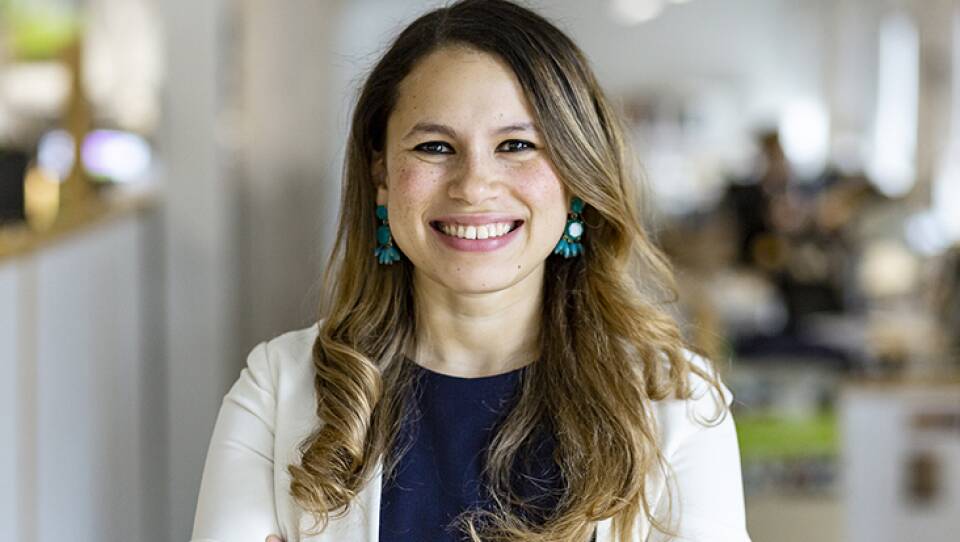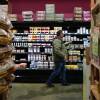Jeremy Siegel: You're listening to GBH's Morning Edition, and we are going to return to the viral story that has gripped Boston this summer: the cop slide. The video you were hearing there shows a cop flying down the metal slide on City Hall Plaza at immense speed, getting tossed side to side and then flying off the bottom of it onto the ground. Now, for most people seeing this video, questions came to mind, like, how is it possible to go down a slide at that speed? Why was a police officer doing this? And can other people achieve that speed? But for one person, some different thoughts came to mind.
Diana Fernandez: I have to say that the cop slide, it's meant for children, one.
Siegel: That's Diana Fernandez, deputy chief of urban design for the city of Boston. And while she was concerned about the safety of the incident, she was also thinking about design, specifically the fact that the slide now known as the cop slide is hugely popular and was even before the video. And it's all part of a huge recent upgrade that was done at City Hall Plaza.
Fernandez: For me, it is a representation of, you know, our community coming together and creating a place for family and children and in a way that we hadn't before.
Siegel: Plazas and playgrounds and every little piece of the things that shape the way we interact with where we live, whether it's in a viral video or not — Fernandez says these are all integral parts of what make a city a city. I talked with Diana Fernandez about what exactly urban design is, why it's important to Boston and her personal journey into the field.
Fernandez: I grew up in the Dominican Republic and I grew up in a rural village, we didn't have running water or electricity. And I remember immigrating to the United States for the first time, and we landed in New York City, and it's just this concrete jungle. And I remember my experience of urban design for the first time in that arena.
Siegel: What exactly is urban design?
Fernandez: So urban design, just imagine when you wake up in the morning and you get out of your house and you're walking the streets and you're commuting to your job. The spaces that you experience as you get to those, get to your job, that's urban design. It's the architecture, the facades, the sidewalks, the open spaces, the streets. It's really the fabric that ties our city together and that we all move through. So in a way, it's really the broader umbrella for how we create life in the city and create a sense of community.
Siegel: So that's the broad umbrella. What specifically are you and your organization working on in the city of Boston?
Fernandez: My organization is really focused on a wide range of efforts. So on the day to day, I see everything from someone's proposal to engage in an addition to their house that requires, you know, zoning, really ZBA, all the way up to masterplans that are focused on, you know, growth areas in our city that are 30 acres or larger. So it's really a wide range of imagining where our city is going and seeing the type of architecture, design and open spaces that really creates a world-class city.
Siegel: What does good urban design mean to you? Like what actually creates a world-class city? Are there examples of it either in Boston or in other cities across the world that you think we can turn to and be like, this is what will make our lives better?
Fernandez: I think here in Boston we are known to be a walkable city, to be a city that is made up of all these distinct neighborhoods. So, for example, the Greenway in East Boston, and especially adjacent to the new library, it's a space where you see all walks of life coming together. You see street vendors selling fruit, you see people gardening in the community gardening plots, folks walking their dogs, people, you know, children playing at the playground. And it's really this place where all of us are sort of coming together. And I think it's a really incredible example of the type of diversity and city that's designed with this notion of celebrating people and creating community. It is. So to me, I think that is an incredible example of what design excellence means and what good urban design is in our city.
Siegel: You have an interesting background with urban design, especially in Boston, because you're someone who grew up in the Dominican Republic. Tell us a little bit about what led you both to urban design as a field and also to your current position in the city of Boston.
Fernandez: As I entered my career as an architect and designer — and as a landscape architect, I'm trained as a landscape architect — I really wanted to find ways in which I could allow for design to reflect the identities of people of my background, to allow design to really create those pieces and those moments where, you know, as a kid I remember playing with the hydrants and in my block and I remember what that did for transforming those streets. And you know, what led me to this work after practicing for many years is this ability to try to give back to the community, to try to ensure that design is actually reflecting the diversity of our places, the diversity of our people, and that it's really centered on that, that at the end of the day, design solutions really support our well-being as human beings and support democracy. We have been working on the Boston design vision over the last several months. It's an effort we kicked off in February of this year. It's an effort where it's the first time we're engaging our residents in a conversation around, what do you think good design is? Imagining our city as a place where we can think beyond the triple decker, where there may be new opportunities for middle housing that allow for intergenerational living, that allow for affordability, or, you know, first-time homeowners to live with their grandparents or live with other family members to support those costs. So to me, that's my dream, that Boston is a haven for diversity, a haven for design excellence. That's not just about, you know, glossy images on the front of an architecture magazine, but actually places that our residents and our communities love and take joy in every day.
Siegel: Boston Deputy Chief of Urban Design Diana Fernandez. Really great talking with you. Thank you so much for coming on.
Fernandez: Thank you for having me.
Siegel: This is GBH News.
Diana Fernandez, deputy chief of urban design for the Boston Planning & Development Agency, remembers her first time in a big city.
“I grew up in the Dominican Republic, and I grew up in a rural village, we didn't have running water or electricity,” she said. “And I remember immigrating to the United States for the first time, and we landed in New York City, and it's just this concrete jungle. And I remember my experience of urban design for the first time in that arena.”
She remembers playing on her new block in the summer and seeing how one change — like opening up fire hydrants and letting water gush out on a hot day — transformed the street.
Fernandez trained as a landscape architect and went into urban design, working for design agency Sasaki before joining the BPDA under an appointment by Boston Mayor Michelle Wu.
Urban design, she said, is “the fabric that ties our city together.” Her job in Boston’s urban design office has her and her colleagues looking at everything from additions to residents’ homes to 30-acre plots of land that the city has a chance to develop.
“Just imagine when you wake up in the morning and you get out of your house and you're walking the streets and you're commuting to your job,” she said. “It's the architecture, the facades, the sidewalks, the open spaces, the streets. … In a way, it's really the broader umbrella for how we create life in the city and create a sense of community.”
Urban design, she said, is “the fabric that ties our city together.” Her job in Boston’s urban design office has her and her colleagues looking at everything from additions to residents’ homes to 30-acre plots of land that the city has a chance to develop.
“Just imagine when you wake up in the morning and you get out of your house and you're walking the streets and you're commuting to your job,” she said. “It's the architecture, the facades, the sidewalks, the open spaces, the streets. … In a way, it's really the broader umbrella for how we create life in the city and create a sense of community.”
She aims to bring that sense of community to her role.
“I really wanted to find ways in which I could allow for design to reflect the identities of people of my background, to allow design to really create those pieces and those moments,” she said. “What led me to this work after practicing for many years is this ability to try to give back to the community, to try to ensure that design is actually reflecting the diversity of our places, the diversity of our people.”
Fernandez said she sees Boston as a walkable city, a collection of distinct neighborhoods and a place with a lot of personality.
“For example, the Greenway in East Boston, and especially adjacent to the new library, it's a space where you see all walks of life coming together,” she said. “You see street vendors selling fruit, you see people gardening in the community gardening plots, folks walking their dogs, people, you know, children playing at the playground. And it's really this place where all of us are sort of coming together. And I think it's a really incredible example of the type of diversity and city that's designed with this notion of celebrating people and creating community.”
In her first months on the job, Fernandez said she has been working on a design vision for the city.
“It's the first time we're engaging our residents in a conversation around: What do you think good design is?” Fernandez said. “Imagining our city as a place where we can think beyond the triple decker, where there may be new opportunities for middle housing that allow for intergenerational living, that allow for affordability, or, you know, first-time homeowners to live with their grandparents or live with other family members to support those costs.”
The goal, she said, is a city that serves its people.
“That's not just about, you know, glossy images on the front of an architecture magazine, but actually places that our residents and our communities love and take joy in every day,” she said.






